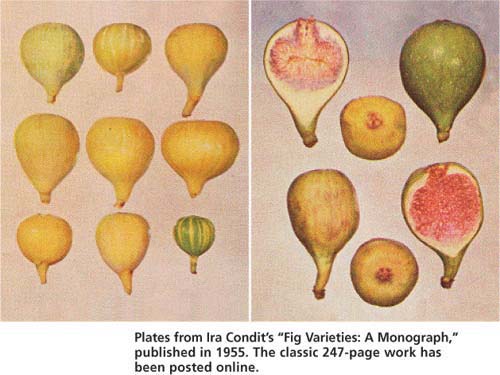All Issues
Letters: April-June 2007
Publication Information
California Agriculture 61(2):52-53.
Published April 01, 2007
PDF | Citation | Permissions
Full text
Classic Hilgardia on figs posted
In February 1955 when Ira Condit's “Fig Varieties: A Monograph” was published in Hilgardia, it was the definitive work on figs. It remains so in 2007. I am pleased that Dr. Condit's publication is now available to anyone wishing a copy as a downloadable PDF at: http://californiaagriculture.ucop.edu/0702AMJ/letters.html .
WHAT DO YOU THINK?
The editorial staff of California Agriculture welcomes your letters, comments and suggestions. Please write to us at 1111 Franklin St., 6th floor, Oakland, CA 94607 or calag@ucop.edu. Include your full name and address. Letters may be edited for space and clarity.
This PDF is the result of more than 135 hours of patience, scanning, optical character recognition (OCR) conversion, retyping unrecognizable text and most importantly, editing for accuracy. Despite the effort, there are still punctuation errors and no doubt typographic errors resulting from the OCR conversion. Although there have been some minor changes including eliminating hyphenation and placing some text on adjacent pages for easier reading, it is my hope that none of the original publication's intent has been lost in the PDF.
Plates from Ira Condit's “Fig Varieties: A Monograph,” published in 1955. The classic 247-page work has been posted online.
Since most fruit production is totally dependent on microclimate conditions and finding suitable varieties, I initiated the Puget Sound Regional Fig Variety Test in 2000 to determine which fig varieties will produce best for home gardeners in western Washington state. The best available information was necessary, hence the need for Dr. Condit's publication.
Bob “Kiwibob” Glanzman, Proprietor
Puget Sound Kiwi Co.
Seattle, Washington
Editor's note: Hilgardia, a monograph series published by ANR, ceased publication in 1995. Copies can be found in university libraries. We cannot confirm the detailed accuracy of this 247-page document, but we gratefully acknowledge Glanzman's heroic effort.
Radiofrequency promising for herbs
Re: Lagunas-Solar et al. “Radiofrequency power disinfects and disinfests food, soils and waste-water” (October-December 2006).
Golden State Herbs in Indio farms 600 acres of conventional and organic herbs, and operates an air-drying facility. We ship our herbs globally, and are the largest grower/processor of air-dried herbs in the United States. The herb and spice industry has relied on various gases, steam or even irradiation for sterilization. This article fascinated me, and I would like to know if the work is applicable to air-dried herbs and spices.
Jack Vince, Vice President
Golden State Herbs, Indio
Manuel Lagunas-Solar, research chemist with the UC Davis Crocker Nuclear Laboratory, responds: Indeed, radiofrequency power is an excellent optional procedure for simultaneously disinfecting and drying herbs, dried food and food-additive commodities. We have studied the dielectric properties of various herbs and spices with excellent results. The chemical composition of dried products makes them very efficient in absorbing radiofrequency power to convert it to thermal energy. In this process, we achieved about 90% overall energy-use efficiencies at selected frequencies, making the economics of the process attractive as well. The radiofrequency process is an efficient and reliable alternative to replace chemical-based, conventional heating and irradiation.
At our laboratory, we have several prototype systems available for demonstration projects. One such system is being prepared for technical demonstrations in Antalya, Turkey, and we are considering projects with private companies in China, Brazil and Canada.
Keep on publishing
I read every issue of California Agriculture and forward or route it to people who should read the information that I feel is in their line of work. As a teenager I attended Picnic Day at UC Davis (1955) and learned about agriculture, not college. After working for 44 years — 20 years at Crocker Bank (computers) and 24 years for the city and county of San Francisco (PUC computers) — I have used the information in the magazine for databases in portfolios, engineering, water samples and more important, my daily life and raising a family of five. Please continue to publish your magazine (as well as post it on the Web) because online publications get lost, whereas magazines can be reread, routed and filed easier for future reference, and used as references in business, work, schools and home.
Bill Flaherty
San Francisco
Appreciates e-mail notification
Editor's note: California Agriculture provides an e-mail notification listing highlights of each new journal edition as it is posted on the Web. If you wish to sign up, please write to CalAg@ucop.edu.
Thank you for the “mind-tickling” content messages for California Agriculture. I can pick and choose what I want to delve into as I have time. Eventually I get through all the subjects, but it's great for me and my burgeoning schedule to be able to prioritize.
Pamela Cornelison
UCCE Master Gardener
Mariposa





